Pets are great. Pets are cute and cuddly, but require a lot of care. With a pet comes extra fur, extra mess, extra bathroom duties, and extra cleaning responsibilities.

According to the American Pet Products Manufacturers Association, about 70 million households in the U.S. own at least one pet. Whether you’re a new pet owner or you’ve lived a life alongside animals, you probably understand how much their furry selves can wreak havoc on all sorts of things in your home—especially carpets and rugs.
So let’s be honest… Odds are, if you’re here you probably have a pet. You’ll probably love it but… who likes the mesy part? Anyhow… as it is a tedious task to tackle, here we I am to help you do it the right way.
Why do pets pee on carpets?
To address any problem it is crucial to know what it might be causing it. In this case, you need to evaluate what’s driving your pet to pee or leave any type of stain on your rugs and carpets.
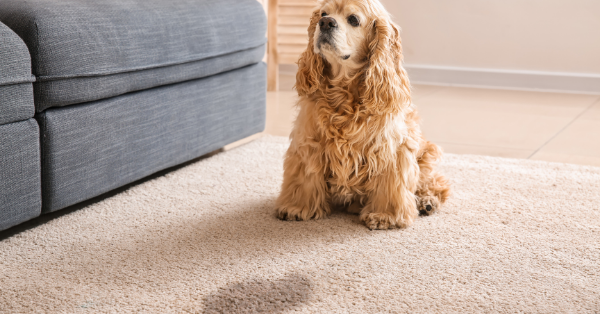
Changing circumstances and new environments tend to alter all animals behavior. If this happens to your pet, you shouldn’t take it personally, since they have no deliberate intention to bother you. As I said, just observe and try to find the reason behind it. It will probably be one of the following causes:
1. Inappropriate Learning/Training. It is considered that a pet has not properly learned where he should or shouldn’t pee or poop when it is more than 6 months old and occasionally continues to pee and poop at home, or when he hasn’t been able to do it outside for a whole moth in a row, and this behavior develops both in the presence and in the absence of the owner. Consequently, he makes his needs wherever he pleases.
2. Insufficient access/outdoor time. This means that your pet doesn’t go out as many times as he needs to the area where he has to pee. And pets that already have an adequate elimination scheme can do so due to changes in the owner’s routine or due to access restrictions to those areas in which he knows he can eliminate. This is especially important in old pets and puppies, since they do not have the same need for eliminations as an adult. There is also the case of pets that are too shy or fearful that they will not eliminate until they are in a safe place for them.
3. Marking of the territory. Another factor why pets tend to urinate where they shouldn’t is due to insecurity. It is more frequent in males than females. Therefore, they “mark the territory”, to reaffirm themselves before other animals. It is also another way of manifesting anxiety. Taking him for a walk is a way to regulate this, in addition to giving them natural anxiolytics that reduce their insecurity or alteration. Castration can also prevent or decrease it.
4. Excitement. More common in young pets and puppies, as they still have no control over the sphincters. The more excitement we cause them, the worse. The urine is not evacuated with a specific posture, but while your pet walks or jumps.
5. Fear. In the same way as over-excitement, fear can cause your pet to have uncontrolled urine emissions. Animlas who have had traumatic experiences, may present this difficulty. In this case you have to be very sweet and diligent with them and try not to panic. You must gain his confidence and receive tolerant treatment. Make gestures of approval if you approach and warn the family to be careful with the details that frighten him.
6. Search for attention. Sometimes, pets try to get the attention of their owners by eliminating inside the house, either to be accepted, to be taken outside, or simply to be scolded.
7. Medical problem. Ruling out a medical cause is the most important in the diagnosis of a possible behavioral problem. The diseases that most frequently can cause polyuria (pee emission in greater quantity) are those of the urinary tract. If all the above causes are discarded, the best option is taking it to the vet to check that it doesn’t have health problems or physical incontinence.
As you’ve seen, there’s a long list of possible causes to look for. Sometimes it will be very clear which one it is and sometimes it’ll take more time to decipher. Just be patient. Once you have the cause, you’ll be able to address it and find a solution.
How to remove New pet stains
Now that we have a better understanding of what’s driving our pets to eliminate where they shouldn’t, let get into business and get that stain out.
This section will walk you through the process of cleaning up stains right after they happen. Don’t worry—we’ll talk about how to prevent them later on.
You might be asking yourself why I made the difference between new (recent) pet stains and old ones.
Well… it’s just a matter of timing. Cleaning a stain directly after the accident is much easier than old pets stains.
So, the first and most important advice is to never let a pet stain dry. Clean it inmediately after the disaster happens!
Grab the following materials you’ll need and get that stain out!
– Paper Towels or Cloth Towels
– Cold water
– Heavy object
– Enzymatic cleaner (here you can also create you own DIY pet stain cleaner solution here).

Once you notice the stain (let’s say urine, as it is the most typical pet stain you’ll have) you need to follow this steps:
Once you notice the stain (let’s say urine, as it is the most typical pet stain you’ll have) you need to follow this steps:
1. Absorb all the urine. Use paper towels. Lay them on top of the stain and apply enough pressure to soak up as much as you can. Use a heavy object (like a book) to help you.

2. Moist again the spot. To do this, you’ll have to wet again the urine spot with cold water. But be careful! First, pour it around the perimeter and then inwards. This way you’ll prevent the water from spreading the urine throughout the rest of the carpet. Leave it a minute or so.
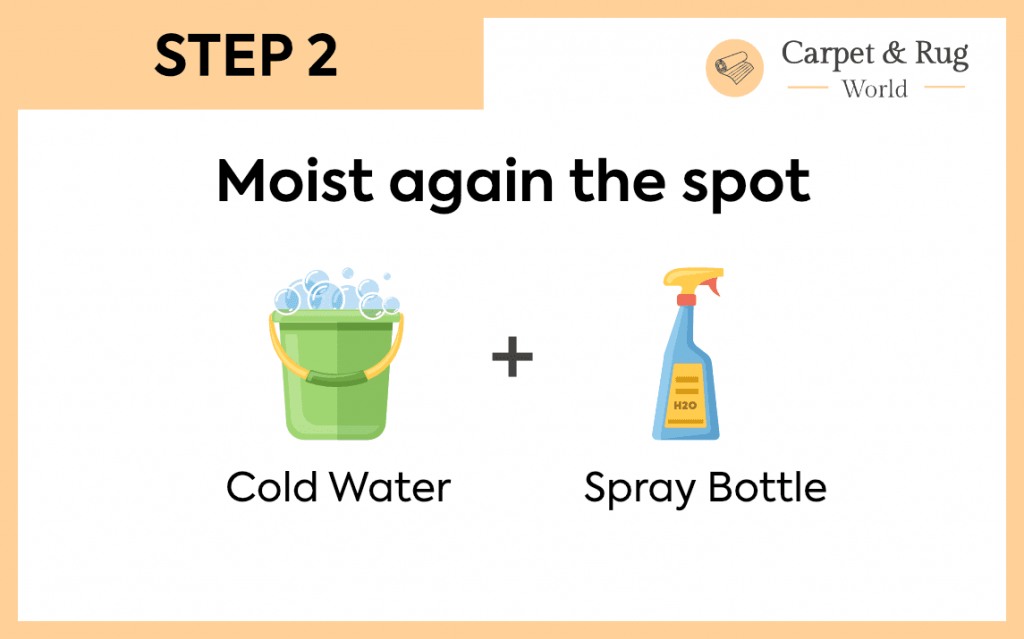
3. Spray the affected area with the enzymatic cleaner or the DIY cleaning solution you’ve made. Enzymatic cleaners, which are non-toxic and effective, may have other benefits added aside form cleaning stains, such as removing bad odors and drive away your pets’ need to urinate all over again in the same spot. Before applying it, read the warnings and follow the instructions.
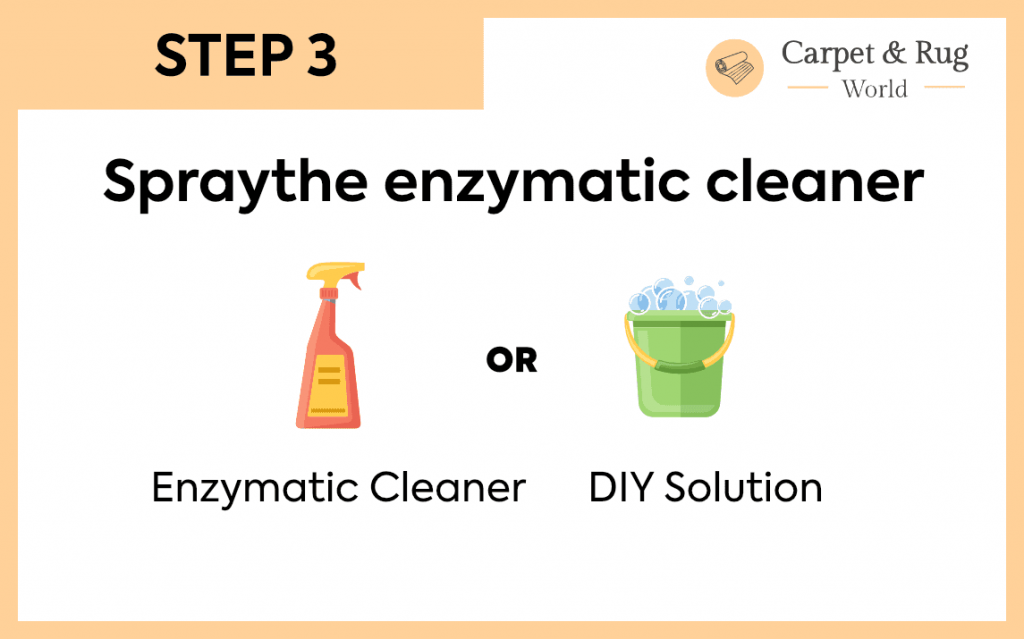
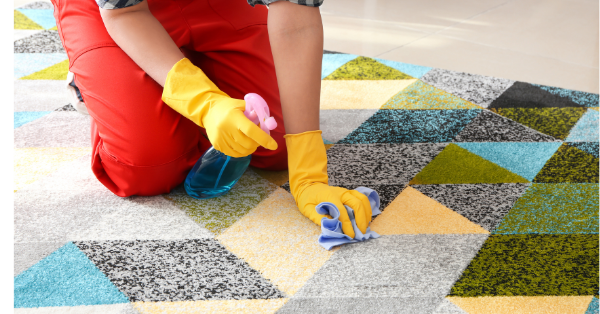
4. Take a clean towel and repeat step 1. Let the towel stay all night with a heavy object on top to help the absoption process. on the stain overnight and put a heavy object, such as a book or something similar that allows faster absorption. The next morning, when you remove the towel, both the stain and smell should have disappeared.
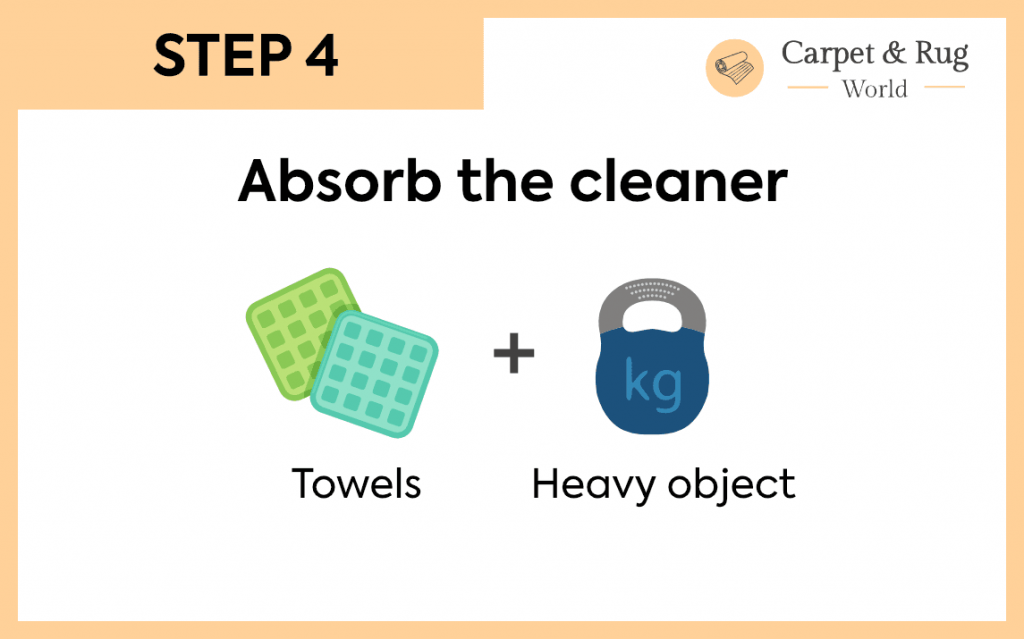
5. Let it dry. If the stain has disappeared, then let it dry. If the stain hasn’t gone away, then try steam cleaning it or hiring a professional to do it.
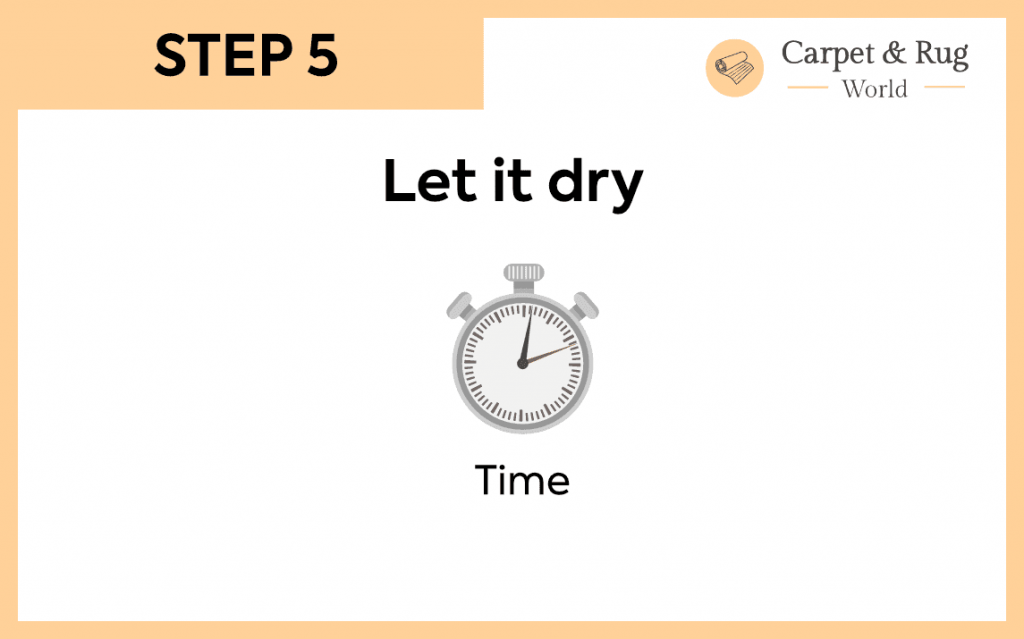
How to remove Old pet stains
Sometimes we’re not able to clean what our pets mess up directly after because we don’t see them doing it… or because we can’t stop everything we’re doing at the moment just to clean up the mess. Don’t worry! It has happened to all of us, pet owners.
Here’s what you have to do to eliminate your old pet stains:
1. First, you need to search. Look for possible old stains where your pet usually urinates or messes up. Smell is also another great indicator of where the stain might be. Urine stains usually turn into a greenish-yellowish color.

PRO-TIP
If you want to be more thorough on your search, use an ultraviolet light to explore even further. Look for stains during the night or turn off the lights to have the maximum darkness. This way it’ll be easier to find them.
PRO-TIP
If you find many spot and don’t want to forget where they are, mark them with a colored tape.
2. Moisten the stain area. Use cold (if possible, distilled) water, pour a small amount around the perimeter moving from the outside of the area to the center.
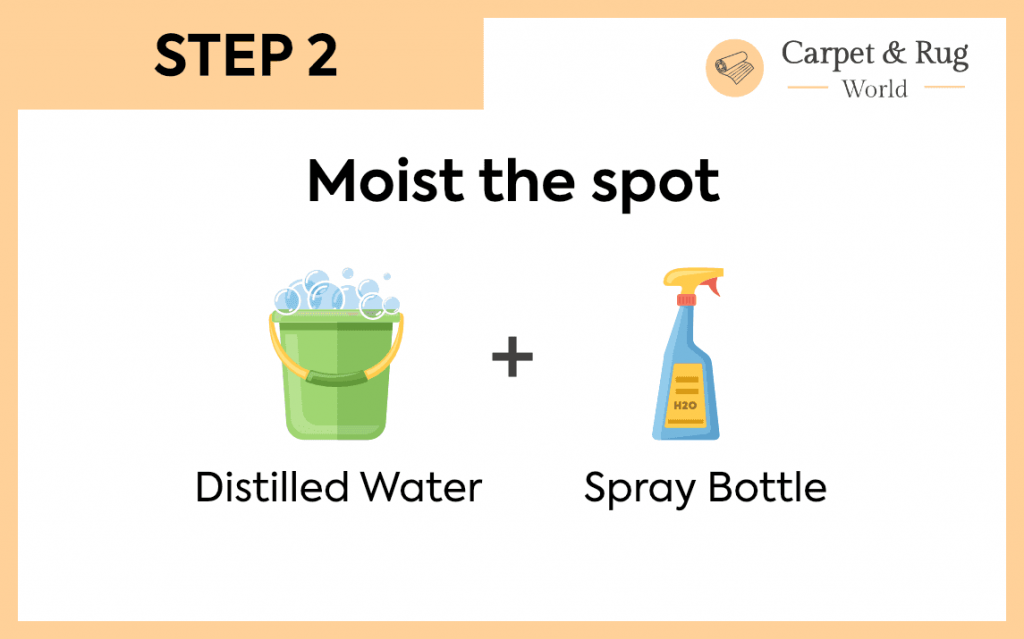
3. Spray an enzymatic cleaner. Spray it on the wet stain and let it work overnight. Before applying it make sure it is safe to use it depenting on the type of fabric your rug or carpet has.
CAUTION!
Wool Rugs and Carpets are more delicate. Make sure you are using a wool-friendly cleaner.
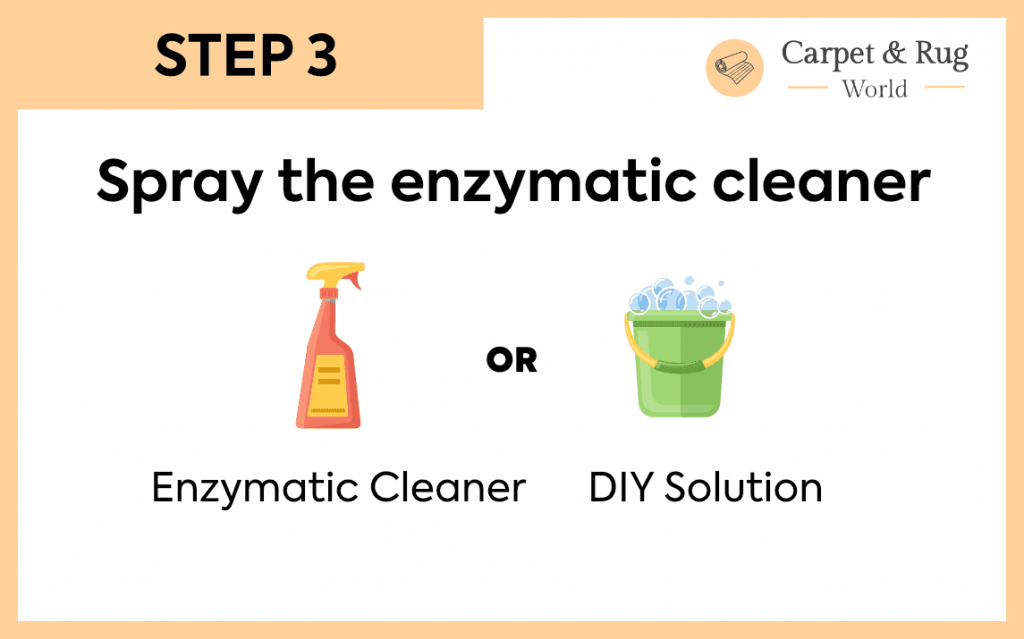
4. Moisten some paper towels with cold water and place them on top of the stain with a heavy object on top to help them absorb as much as they can. Leave it overnight and if the next morning they’re still there, consider applying more extreme measures.
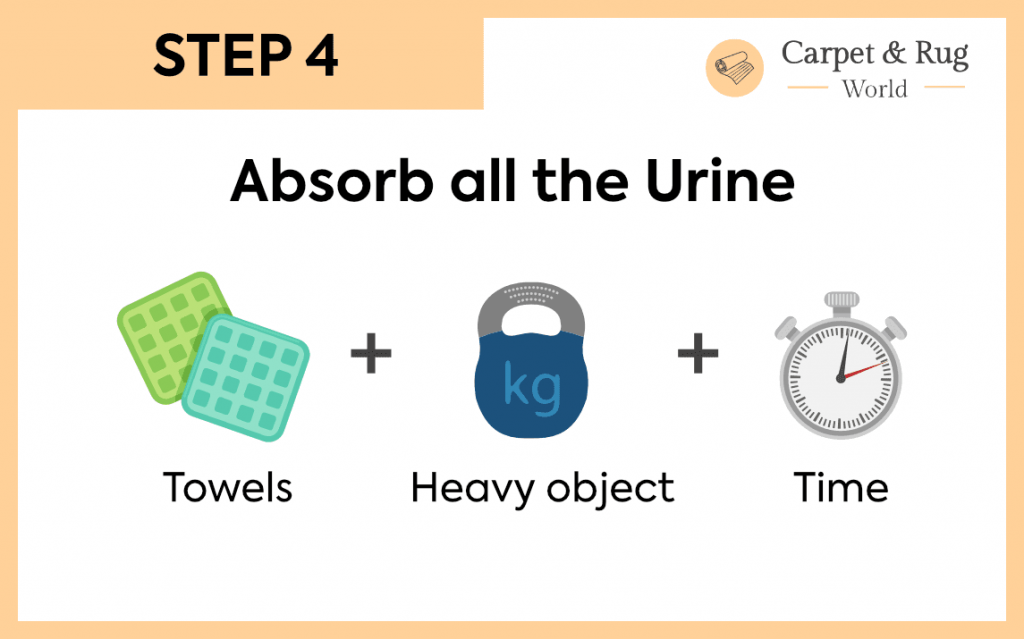
If the stain doesn’t go away, try steam cleaning it, creating your own DIY cleaner solution, or hiring a professional carpet/rug cleaner.
Types of pet stains
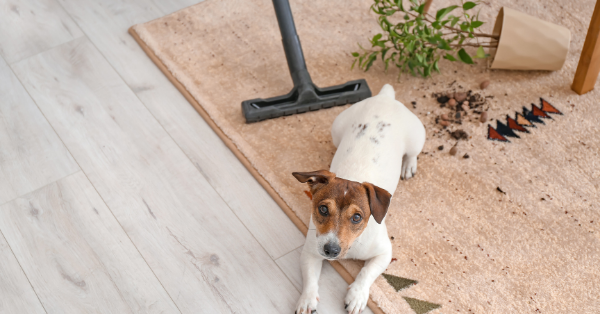
I’ve been talking generally about urine stains for the sake of simplicity but there are other stains caused by your pets and they might not be that obvious. Here’s a breakdown of carpet stains and odors commonly caused by your pets:
– Urine
As we’ve talked before there are many causes to why pets pee where they shouldn’t, even if they’re well-trained. Urine not only produces an odor that lingers, but it also leaves a colorful mark on your carpet. To take urine stains out just go through the steps described above. And if you want to DIY it, create your own pet stain remover.
– Feces
The good news is usually feces don’t sink into the carpet as easily as liquid spills or stains. It’s still not your favorite thing to come home to, but the cleaning process is a little easier. Most importantly, you should be careful not to squash the feces when trying to remove them. Put some gloves on and just lift it up. You can use a staptula if it makes it easier. Then go through the steps described above and that would be it!
– Saliva
This may sound crazy, but pet saliva can leave an odor in your carpet. So, if you begin to smell a weird odor in your carpet, it could be drool or a combination of drool and something else. It’s colorless, which is a plus, but it still should be cleaned for sanitary purposes.
– Vomit
For some pets, it may be a hairball. For others, it could be a regurgitation of last night’s meal or something they shouldn’t have eaten. A lot of people brush this stain/odor off as something that can be quickly and easily cleaned, but it really should be taken seriously for the sake of your home’s sanitary needs. A good tip would be to use a wire brush that is normally used for pets to comb the area. Do it from side to side until most of the vomit has been removed.
– Fur, dander and dirt
When fur gets wet, it produces a smell. And also fur alone can make your rugs and carpet look a bit dirty… and not too hygienic. Try vacuuming it with a brush attachment that will comb the fabric of your your carpet and applying the following stepst to eliminate any bad odor they might have left on you carpets.
Luckily, it’s pretty rare that ALL of these odors and stain causes happen at the same time. In fact, it’s usually not something you’ll be dealing with on a daily basis, unless you’re working with a new puppy that needs to be trained.
How to eleminate pet ODORS
Pet odors might seem easier to get rid off than stains but they can be trickier sometimes.
On the other hand, as pet odors can exist without being too nasty or leaving a stain on our rugs and carpets, we might let them be as long as they don’t catch our eye or nose… But what we don’t know is that any smell has a cause, and that cause could be damaging our rugs and carpets forever.
For this and other many reasons, we should always try to keep our rugs not only stain-free but bad odor-free.
Here’s what you’ll need:
– Vacuum cleaner
– Sodium bicarbonate
These are the steps:
1. First things first, vacuum thoroughly to remove any large particles. If it’s a manageable rug, shake it carefully to remove the smaller particles that the vacuum cleaner could not catch.
PRO-TIP
If the weather allows it, open the windows and let the fresh air run for as long as possible. Sometimes this measure is enough for odor removal but not for cleaning.
2. If the odor comes from a stain, then remove the stain following the steps described in one if the sections above in this article.
3. If the odor keeps staying, then the best tip is to use sodium bicarbonate (also known as baking soda). Apply it over the entire surface of the rug or carpet. Let it rest as long as possible,at least 2-3 hours, but even 24 hours will be needed at times if the smell is too intense. The longer, the better.
PRO-TIP
If in addition to removing the smell you want to perfume it, add a few drops of essential oil to the bicarbonate before throwing it on the rug or carpet.
4. Proceed to vacuum again. Be sure to collect all the dust.
And that would be it! Remember, sodium bicarbonate is great when cleaning almost anything because it isn’t toxic, it will help you get everything clean and hygienic and it’s safe for your health, your family and your pets.
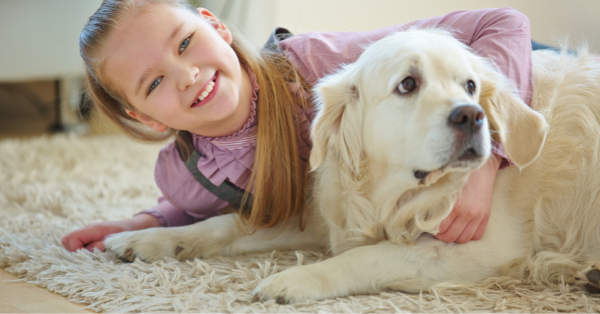
Prevent Pet Stains and Odors with these 5 tips
Getting rid of bad odors from a rug or carpet is important to keep our homes safe and hygenic for ourselves and families, but it is even more important to avoid or prevent future disasters. And when talking about pet stains and odors there’s much we can do about it!
Here are some tips:
– Create and teach your pet a routine so that he knows where and when he’s allowed to pee. If you find it impossible to teach you pet, another possibility is to hire a dog trainer to do it for you. They can be a bit expensive but will save you from a lot of trouble!
– Give you pet a bath if the vet allows it and as often as he recommends it.
– After a walk or spending time outside, use wet wipes or cloths to clean their legs.
– Brush your dog’s fur regularly on a surface that is easy to clean, such as a tile floor.
– Make their bathroom area stand out!
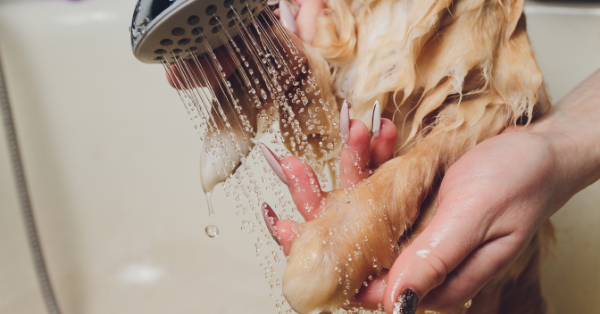
See? There are plenty of things you can do to prevent bad odors and stains! Not to mention, you’ve made it through the worst part: the clean-up.
Remember! Upkeep is easier than clean-up. If you can master the art of preventing pet stains and odors on your rugs and carpets, you’re in a good place.
Conclusion: Pets and Rugs…You can have them both!
Still feeling a bit overwhelmed? Keep in mind, this is part of owning a pet. Every once and a while they have a slip-up, but all in all, they’re great to have around. Try to remember this if you’re ever feeling frustrated. We know it can be a pain to deal with stains and odors, but they’re not impossible to deal with.
After reading this article you should feel like you’re ready to treat and prevent all types of pet odors and stains! You’re probably a pro!
Now it’s time to clean!
Don’t fear the thought of pet stains. You are not alone. Pet owners all over the world are dealing with similar issues this very minute. The important thing to remember is your “why,” which is the love and comfort that comes with owning a furry friend. Your pet and your carpet can get along just as well as you do with your pet—it just takes some time, patience, and a little effort.
